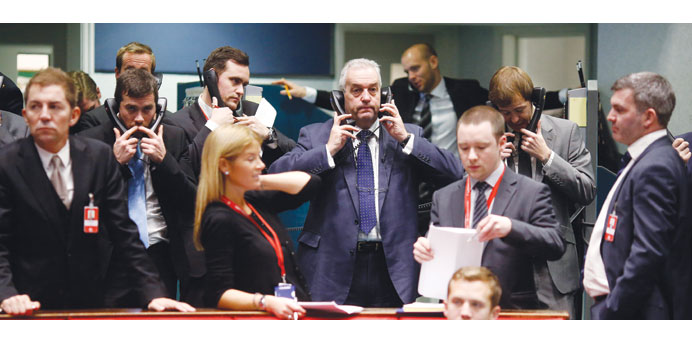Traders use telephones as they work on the trading floor at the London Metal Exchange. The LME has announced a new raft of rule changes aimed at killing off the persistent load-out queues that have bedevilled its relations with large parts of its industrial user base.
By Andy Home
London
The London Metal Exchange (LME) has just announced a new raft of rule changes aimed at killing off the persistent load-out queues that have bedevilled its relations with large parts of its industrial user base.
Effective March next year standard load-out rates from LME warehouses will be raised. Again.
Previous increases have, somewhat counter-intuitively, only served to lengthen the queues since warehouse operators simply increased their load-in of metal to compensate. But this loophole has now been closed by the LME’s requirement that all operators with a queue load out more than they load in (LILO).
Then, effective May, the LME will introduce its queue-based rent cap (QBRC), which means that the rent payable on metal stuck in a queue longer than 30 days drops by half and is eliminated altogether after 50 days. The so-called QBRC comes with “anti-abuse” clauses to stop players trying to game the system to get lower or no rent.
Both measures are controversial and some sort of reaction from LME warehouse operators is highly likely, whether it be in the form of a legal challenge or higher charges for storing and loading out metal.
Nor, ironically, is it even guaranteed that existing queues, particularly that at the Dutch port of Vlissingen, won’t flex out again in the short term.
The LME, however, has very little choice in the matter. Its problem is that while the two most persistent queues at Vlissingen and Detroit have fallen thanks to LILO, they “remain higher than is desirable for the orderly functioning of the market,” according to the LME.
The wait time to get aluminium out of warehouses in Detroit owned by Metro was still 236 days at the end of last month. At Vlissingen, where Pacorini “owns” the load-out queue, the wait time was 311 days.
Either way, it’s still a long time to have to wait to get metal out of an exchange warehouse. Too long for the LME. And too long for financial regulators.
No LME document on its physical delivery function is now complete without several explicit references to the British financial regulator the Financial Conduct Authority (FCA) or the LME’s need to “ensure that its warehousing arrangements operate in a way that enables the LME to continue to satisfy its regulatory obligations.” And the latest, the snappily-titled “Amendments to the policy on approval and operation of warehouses (implementation of LORI and QBRC) and clarification of certain points relation to the LME’s physical delivery network”, is no exception. Moreover, it is an open secret that US regulator the Commodity Futures Trading Commission (CFTC) has been exerting pressure behind the scenes for the LME to sort out once and for all its warehouse issues.
Even if the LME were minded to allow the queues slowly to decay under the LILO formula, regulators on both sides of the Atlantic aren’t going to be so acquiescent.
The target is 50 days maximum queuing time and the intention is to get there as soon as possible.
The only problem is that the immediate result of the new measures is likely to be longer queues, particularly at Vlissingen.
The LME “has always noted that the short-term effect of any policy aimed at reducing queues by giving metal owners more ready access to their metal may be, paradoxically, a short-term increase in queues, given that metal owners would look to take advantage of that policy by accessing their metal.”
This is less a problem at Detroit. As of the end of last month Metro was storing 101,700 tonnes of on-warrant metal. Even if it were all cancelled in one go, the impact on queue length would be short-lived.
Pacorini in Vlissingen, on the other hand, still had 782,283 tonnes of live stock at the end of October, most of it aluminium. That’s a lot of metal, sufficient to push out the queue significantly if the owners choose to cancel their warrants and move the metal elsewhere.
Indeed, it may already be happening. As the LME itself notes, some 556,100 tonnes of primary aluminium were cancelled at Vlissingen between October 26 and November 13.
It “may be the case”, the LME noted, that this is owners pre-empting the possibility of lower rents after QBRC is introduced next year.
It may also be the case that others follow suit. Evidently, if they do, that queue, 311 days at the end of October, could get a lot longer before it gets shorter.
But under QBRC, Pacorini’s ability to make money from a longer queue will be severely constrained.
How will it react to this direct challenge to its bottom line?
The LME has been explicit that QBRC comes with heightened legal uncertainty but “cannot discount otherwise appropriate policy action simply because of the threat of litigation being launched.”
l Andy Home is a columnist for Reuters. The opinions expressed are his own.



